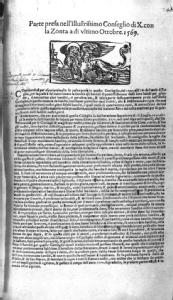Print and communication
Seminar Tutor
Luca Molà
Site Visit
The Biblioteca Marciana. Meet at the entrance to the Biblioteca Marciana.
Seminar Questions
- Why was the printing industry so successful in Venice?
- How and why did the Government and the Church seek to control the press? How successful were they?
- To what degree did printing alter the dynamics of Venetian literary culture?
- How did print interact with existing cultures of manuscript and oral communication in Venice?
Key Texts
- Chambers, David, and Brian Pullan (eds), Venice: A Documentary History 1450-1630 (Oxford, 1992; rept. Toronto, 2001) , pp. 369-75.
- Infelise, Mario, 'Book Publishing and the Circulation of Information', in Dursteler, A Companion to Venetian History, 1400-1797 (Leiden, 2013), pp. 651-74.
- Diana Robin, "Courtesans, Celebrity, and Print Culture in Renaissance Venice: Tullia d'Aragona, Gaspara Stampa and Veronica Franco", in Italian women and the city: essays, edited by Janet Levarie Smarr and Daria Valentini (Madison, 2003).
- Rospocher, Massimo, 'In vituperium status veneti. The case of Niccolò Zoppino', The Italianist 34.3 (2014): 349-61.
E-Resources
- La Bibbia nel ‘500
- Manuscript and Print Sources for the Study of Inquisition History - from the Library of the University of Notre Dame
- Primary Sources on the History of Copyright
- Edit16 - Censimento nazionale delle edizioni italiane del XVI secolo
Further Reading
- Carroll, Linda, 'Venetian Literature and Publishing', in Dursteler, A Companion to Venetian History, 1400-1797 (Leiden, 2013), pp. 615-50.
- Rosa Salzberg, Ephemeral City: Cheap Print and Urban Culture in Renaissance Venice (Manchester, 2014)
- Rosa Salzberg, "Selling Stories and Many Other Things In and Through the City: Peddling Print in Sixteenth-Century Florence and Venice", Sixteenth-Century Journal, 42 (2011), n. 3, pp. 737-759.
- Rosa Salzberg, "In the Mouth of Charlatans: Street Performers and the Dissemination of Pamphlets in Renaissance Italy", Renaissance Studies, 24/5 (2010), pp. 638-653.
- Rosa Salzberg, "Print Peddling and Urban Culture in Renaissance Italy" in Not dead things: the dissemination of popular print in England and Wales, Italy, and the Low Countries, 1500-1820, edited by Jeroen Salman, Roeland Harms, Joad Raymond (Leiden, 2013), 33-52.
- Christopher May, "The Venetian Moment: New Technologies, Legal Innovation and the Institutional Origins of Intellectual Property", Prometheus 20, n. 2 (2002): 159-179.
- Brian Richardson, Print culture in Renaissance Italy: the editor and the vernacular text, 1470-1600 (Cambridge & New York, 1994).
- Christopher Black, The Italian Inquisition (New Haven, 2009), chapter 7.
- Deborah Parker, "Women in the book trade in Italy, 1475 - 1620", Renaissance Quarterly 49(3) (1996): 509 – 541.
- Martin Lowry, The World of Aldus Manutius: Business and Scholarship in Renaissance Venice (Ithaca, NY, 1979).
- Martin Lowry, Nicholas Jenson and the Rise of Venetian Printing in Renaissance Europe (Oxford, 1991)
- Paul F. Grendler, Critics of the Italian World, 1530 - 1560: Anton Francesco Doni, Nicolò Franco and Ortensio Lando (Madison, 1969).
- Raymond B. Waddington, Aretino’s Satyr: Sexuality, Satire, and Self-Projection in Sixteenth-Century Literature and Art (Toronto, 2004), Chapter 2.
- Raymond B. Waddington, "A Satirist's Impresa: The Medals of Pietro Aretino", Renaissance Quarterly 42:4 (1989): 655-68.
- Susan Gaylard, ‘‘Naked’ truth: Clothing, Patronage, and Genius in Aretino’s Letters’ The Italianist 28 (2008): 179-202.
- Craig Kallendorf, “In Search of a Patron: Anguillara's Vernacular Virgil and the Print Culture of Renaissance Italy”, Papers of the Bibliographical Society of America 91, no. 3 (1997): 294 - 325.
- Martin Lowry, “Venetian capital, German technology and Renaissance culture in the later fifteenth century”, Renaissance Studies 2, no. 1 (1988): 1-13.
- Martha Feldman, City Culture and the Madrigal at Venice (Berkeley, CA, 1995).
- Diana Robin, Publishing Women. Salons, the Presses, and the Counter-Reformation in Sixteenth-Century Italy (Chicago, 2007).
- Margaret Rosenthal, The Honest Courtesan: Veronica Franco, Citizen and Writer in Sixteenth-Century Venice (Chicago, 1992).
- Margaret Rosenthal, "Veronica Franco's Terze Rime: the Venetian Courtesan's Defense", Renaissance Quarterly 42:2 (1989): 227-257
- John Monfasani, "The First Call for Press Censorship: Niccolò Perotti, Giovanni Andrea Bussi, Antonio Moreto, and the Editing of Pliny's Natural History," Renaissance Quarterly 41 (1988): 1 - 31.
- C. L. C. E. Witcombe, Copyright in the Renaissance: Prints and the 'Privilegio' in Sixteenth-Century Venice and Rome (Leiden, 2004).
- Richard Agee, "The Venetian privilege and music-printing in the sixteenth century," Early music history 3 (1983): 1–42.
- Horatio F. Brown, The Venetian Printing Press (London, 1891).
- Elizabeth Horodowich, Language and Statecraft in Early Modern Venice (Cambridge, 2008).
- Paul F. Grendler, The Roman Inquisition and the Venetian Press, 1540 - 1605 (Princeton, NJ, 1977).
- Iain Fenlon, The Ceremonial City. History, Memory and Myth in Renaissance Venice (New Haven, 2007).
- Gigliola Fragnito (ed.), Church, Censorship and Culture in Early Modern Italy (Cambridge, 2001), 194-222.
- Anne Jacobson Schutte, "The lettere volgari and the crisis of evangelism in Italy," Renaissance Quarterly 28, no. 4 (1975): 639 - 688.
- Cristina Dondi, "Printers and Guilds in Fifteenth-Century Venice," La Bibliofilia 106, no. 3 (2004): 229-65.
- Ivo Mattozzi, “‘Mondo del libro’ e decadenza a Venezia (1570-1730),” Quaderni storici 72, no. 3 (1989): 743-86.
- Claudia di Filippo Bareggi, "L'editoria veneziana tra '500", in Storia di Venezia (1994).

